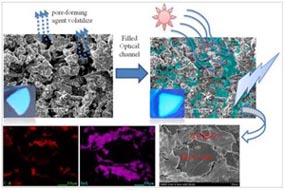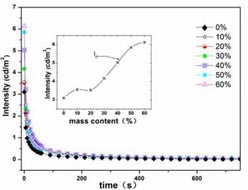ShanXi university of science and technology has made new progress in the functionalization of long afterglow luminescent materials
With the exhaustion of energy and environmental pollution becoming increasingly serious, the development of new energy-saving and environment-friendly materials and products and the improvement of the performance of existing materials have become the focus of scientific and technological development and an important direction for environment-friendly countries to adhere to the construction of ecological civilization. Long afterglow luminescence materials can absorb light, lighting light source after stored energy, and continue to glow, so as to realize no electric light, is a kind of important energy-saving environmental protection material, at present, the commonly used preparation methods of long afterglow luminescence materials for high temperature solid phase method, using high temperature solid phase of long persistence luminescent materials prepared by the grain diameter is larger, in the process of the preparation of powder, easy to damage to higher grain surface energy, so that the substantial decrease in luminescence performance. How to achieve internal luminescence of lump-length luminescent materials without destroying grain defects is an important way to solve this problem, which has a strong practical significance


Recently, under the guidance of seagull teachers majoring in inorganic nonmetallic materials engineering, zhang zhaohui, li dongming and other 15th-grade undergraduates of our hospital proposed a new approach to the functionalization of long-afterglow luminescent materials. By preparing porous long-afterglow luminescent materials, the defect density of grain surface was improved, thus improving the luminescence performance. On the premise of not destroying the crystal defects, the porous long-afterglow luminescent materials are filled with transparent materials to provide light channels, so as to achieve internal luminescence and ultimately achieve light transmittance. The preparation of different specific surface area of long persistence luminescent materials is also a important way to study the distribution of defects, porous long afterglow luminescence materials can provide different types and density of defects, through the study of distribution of defect influence on trap depth and density, which affect the performance of light, finally puts forward a kind of applicability broader long afterglow of trap depth light-emitting mechanism model. The application of porous long persistence luminescent materials was also investigated. In the work of the Dyes and Pigments (if = 3.473, SCI area) journal
In this study, connected porous long-afterglow luminescent materials with different pore distribution and pore size were obtained by adjusting the amount of pore-making agent. Fill the porous material with transparent material to provide light channel, improve and improve the refraction and diffuse reflection of highlights, improve luminescence performance, achieve internal luminescence, achieve transparency and expand its application field. A mechanism model of long persistence luminescence is proposed. The implementation of the project is of great scientific significance to the research, application and popularization of the mechanism of long persistence luminescence.
This work was supported and helped by the teachers’ start-up fund of shaanxi university of science and technology and the innovation and entrepreneurship project of shaanxi university students. The work has been patented.
The thesis links: https://authors.elsevier.com/a/1Wt07WhQSGtTb


 中文
中文